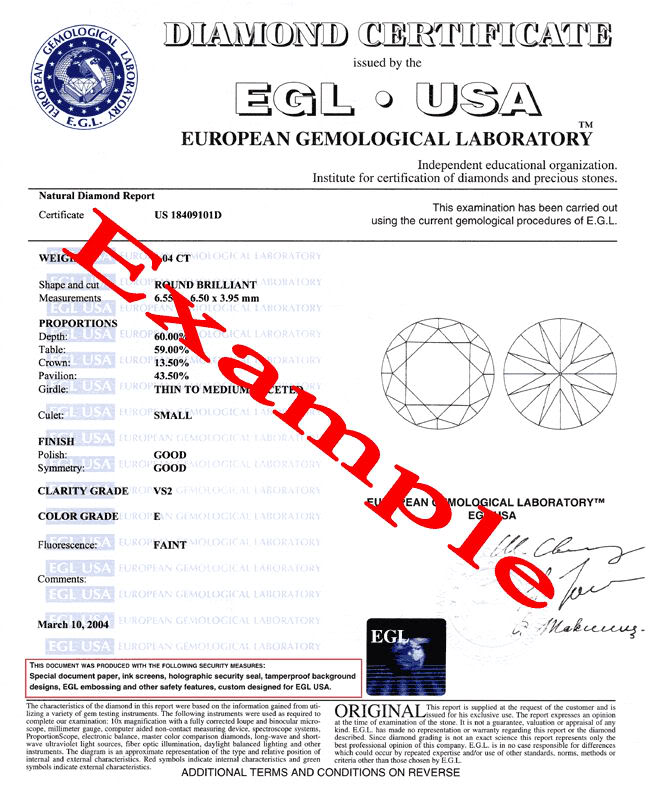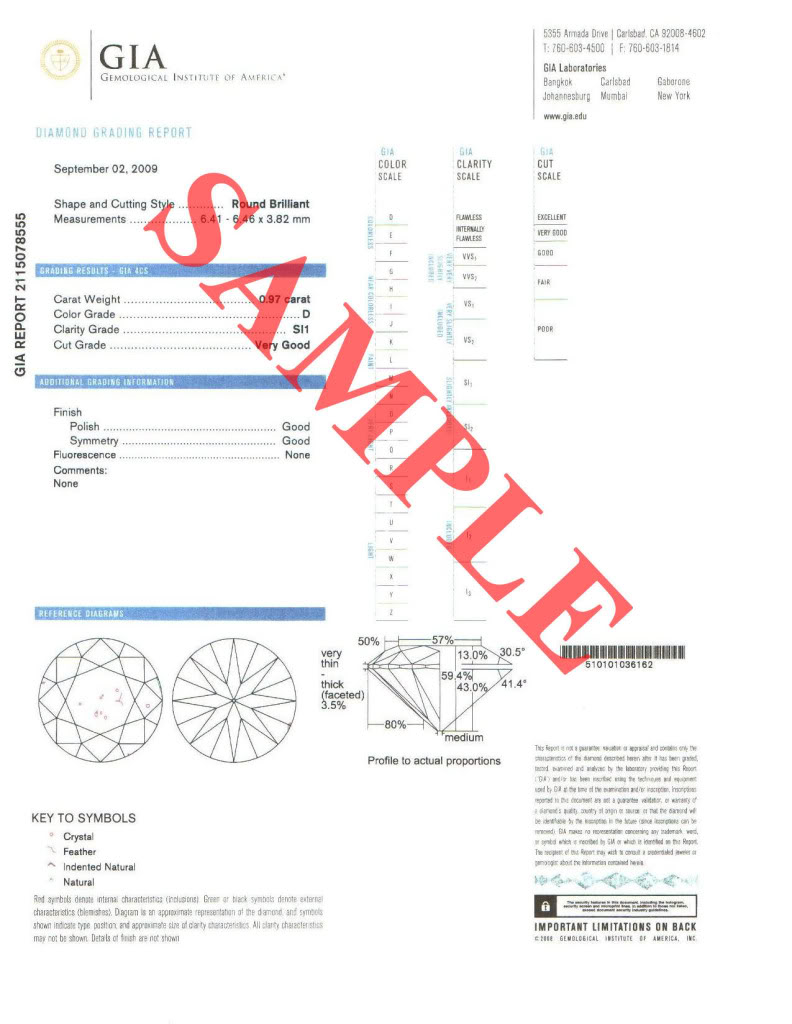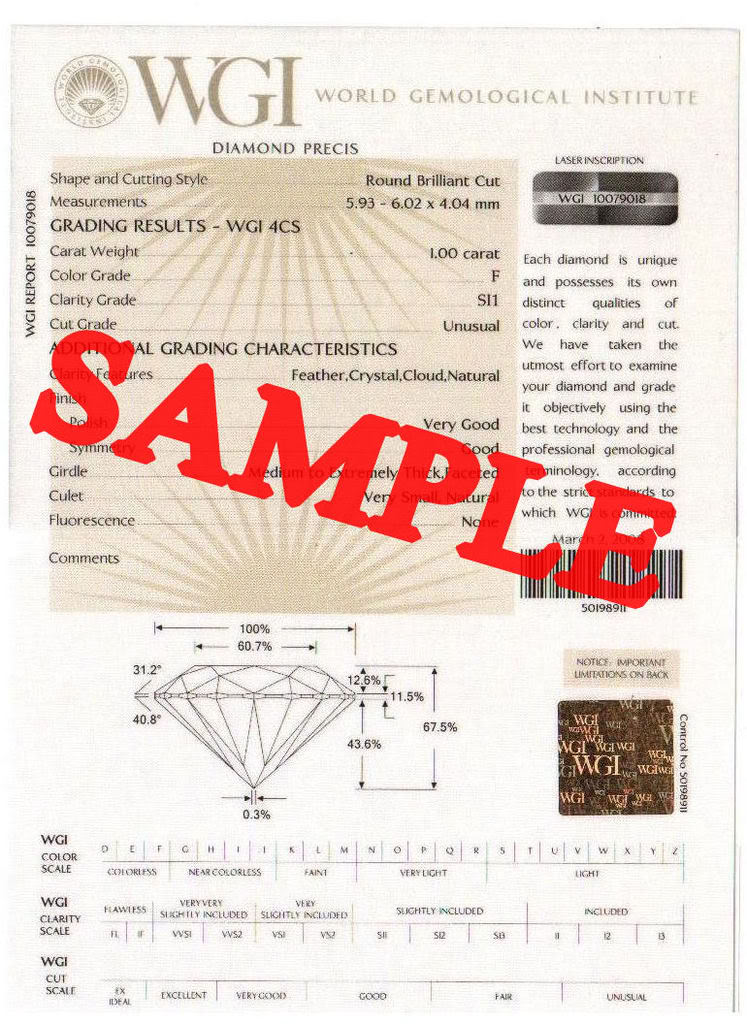We have various GIA
certified diamonds
Certificate EducationWhat Is A Diamond Certificate?
A diamond certificate refers to a diamond grading report. It
can also be called a diamond dossier®, or a diamond quality document.
A certificate is a professional document which reflects a professional
evaluation of a specific diamond.
This
evaluation is conducted in a gemology lab under the supervision of professional
gemologists.
The Top 8 Diamond Labs Worldwide:
   There are many other labs that give very accurate diamond descriptions, however these seven labs are noted for their scrutiny when grading. Each lab has its own characteristics:GIA (Gemological Institute of America) is based in the United States and is considered by diamond dealers and jewelers alike to be the leader in industry standard and is the most widely used and trusted name in the diamond trade. AGS (American Gemological Society) is well-known for its in-depth scientific research into diamond color grades. AGS’s color grading is considered to be superior to GIA’s by some jewelers. HRD (Hoge Raad voor Diamant), EGL (European Gemological Laboratory), IGI (International Gemological Institute), and especially CIBJO (International Confederation of Jewelry, Silverware, Diamonds, Pearls, and Stones) are not as well known in the United States as their American counterparts.Certificates from any of these agencies is a solid proof (but never a guarantee) that you are not going to end up with the diamond that you ordered. 
What Is The Difference Between Labs ?The key differences between the different labs are their diamond color and clarity grading scales. In the last few years some labs made an effort to standardize their grading scales with that of GIA. However, be aware that with older certificates, as the grades may not match current ones. For example, AGS modified its grading system in 1995. Diamonds, like everything else, are prone to wear and tear and on rare occasions diamonds chip, scratch, or crack, thus a certificate that is more than three years old is not going to reflect the accumulated everyday damage if there is any. CostsThe GIA and AGS certifications are more expensive than other labs, due to their scrutiny when grading. Some diamond dealers and manufacturers prefer to send their diamonds to EGL USA, EGL international or IGL labs in order to save money. This practice is usually for smaller diamonds weighing below 0.75 carats in the SI clarity range where the cost of the certificate will cause a drastic raise in the overall cost of the diamond. Time DelayThe GIA and AGS labs typically takes longer to certify diamonds. This means that when the dealer sends his inventory to the lab his diamonds are unavailable to sell or to show. Therefore, they would prefer to send them to labs that are more expedient. SI3 FactorGIA, AGS and IGI do not offer an SI3 clarity which means that imperfections are not visible to the naked eye. In contrast IGL, EGL international and EGL USA do offer SI3 clarity. The SI3 grading is especially popular in the USA & UK because there are many customers who are willing to buy diamonds whose imperfections are hard to see and they can then save money over the purchase of a SI2. For example, a 1.50 Carat Cushion cut G color SI2 clarity with an EGL USA certification costs around $6300 where a similar SI3 clarity would cost $4800. That is close to a savings of $1500.
How Can You Be Sure That The Certificate Belongs To The Diamond?
Since diamonds can seem very similar to an untrained eye, some
diamonds are laser engraved with a serial number on the girdle, to match the
serial number on the certificate. However, this method is not fool proof as the
laser engraving can easily be removed by most jewelers. A safer method of
checking would be to compare certification with the diamond is to ask for an
evaluation by a third party.
Each diamond’s inclusions and measurements are unique. A certificate that plots the diamond’s inclusions is like a person’s fingerprints, there are no two exactly the same. Our RecommendationsWhen choosing a diamond, the reliability of the color and clarity grades (and in some instances the cut grades) is only as good as the certifying gem labs’ reputation. However, there is one important thing to remember is the consistency of the lab. One lab will consistently call one color grade “G” while another lab will consistently call that same color “H”, it’s perfectly acceptable and reasonable — as long as they do so consistently. It is equally important to realize that every lab has its own manner of evaluation some are more lenient in color, and some in clarity. Some will always upgrade specific color ranges, while others favor particular arrangements of inclusions. Buying diamonds online can save consumers a great deal of money. In light of all the different standards, how can one be sure to choose to choose the best diamond that fits their budget and their needs. Make sure to purchase a diamond with at least a 14 day return policy, this insures that you can view the diamond in the comfort of your home and have the ability to get a second opinion. CaratsDirect2U offers a 30 day return policy. Always ask to see actual photos or a high quality video of the diamond before making your decision to purchase. If you have any questions about any of our certified diamonds or non-certified diamonds, mounted or loose please feel free to contact one of our professional jewelers at 1-800-557-7095. |



